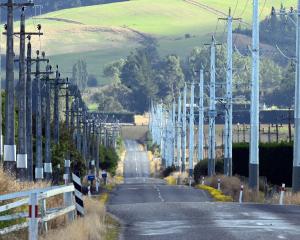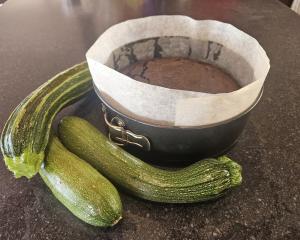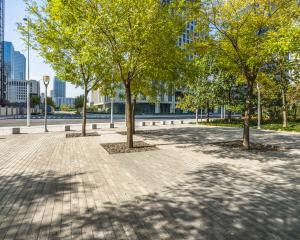
As a gardener I'm a bit of a generalist with minerals, but I don't ignore the needs of my soil and plants.
I put rock dust, seaweed (when available) and a lime/dolomite mix through my compost heaps to ensure there's a broad spectrum of minerals. I love adding weeds, too - they are potentisers of certain minerals, so are great in the compost.
Nitrogen gets so much focus because it is seen as being the most important element in the growing cycle. It's this element that creates the energy that helps plants to grow and then reproduce. Just because nitrogen is the most plentiful element on the planet, it doesn't equate to our soils being abundant in it.
Our soils vary through Otago, but with a common thread; they lack organic matter. It's this organic matter in the soils that serves us so well when we have it; holding moisture, biological life (bacteria and fungi), nutrients and acting as a carbon store.
Nitrogen flows freely through the soil profile unless it has something to bind to.
All our veges want a biologically active soil to grow in, with good nitrogen levels. The bigger the plant, the more it wants to gobble up nitrogen to grow big and healthy.
Carrots are a good example of a crop that prefers a less fertile soil. Classic symptoms of carrots grown in a rich soil are huge top growth with a stumpy small carrot in the soil. Show-stopper carrots are often grown by poking a rod into the soil, filling the hole with sand and sowing a couple of seeds on top, then thinning to one plant later on.
At the other end of the spectrum, a pumpkin plant will give you multiple pumpkins when grown in a compost heap.
There are no silver bullets to getting nitrogen into our soils (well, maybe compost if we can make enough). It's by taking multiple approaches that allows us to create our Gardens of Eden.
And let's not forget that success is about other elements too. Focusing solely on nitrogen will create problems along the way, in the same way as if we keep our blinkers on and just take the classic NPK (nitrogen, phosphorus, and potassium) approach. Let's not forget we need a broad spectrum of minerals in our soils for healthy plants and healthy bodies.
So without further ado let's get into some practical ways of getting nitrogen into our soils for our plants to use.
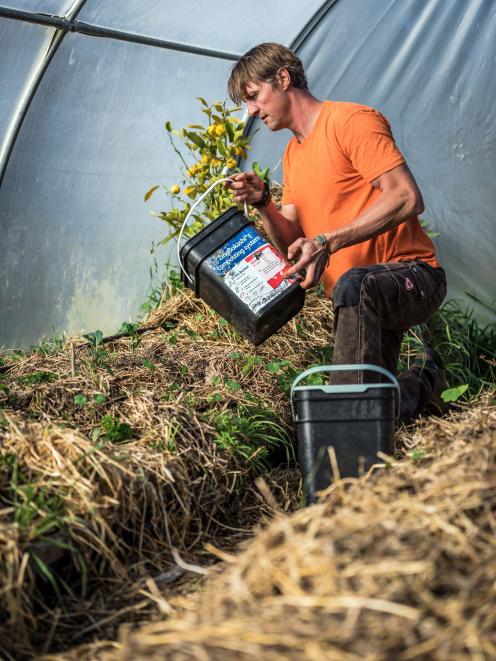 The Bokashi system is a "stomping way of getting a humongous amount of nutrients into the soil with a biological boost".
1. CREATE ORGANIC MATTER IN THE SOIL
The Bokashi system is a "stomping way of getting a humongous amount of nutrients into the soil with a biological boost".
1. CREATE ORGANIC MATTER IN THE SOIL

This is the key to success. There are lots of ways to do this: regular applications of compost, leaf mould, mulch and green manures. Organic matter provides a home for nutrients and soil biology - really they're one and the same.
2. COMPOST
Making good quality compost from a wide variety of ingredients. There is no better way to get nitrogen into your soils and feed your plants over the long term. Compost is alive with billions of bacteria, fungi, protozoa, nematodes and worms, all working to feed your plants.
3.GREEN MANURES
Green manures are a great way of building organic matter. In a few minutes I'm going to contradict myself by telling you not to turn the soil. This is the exception.
Sowing the commonly available green manure mix (lupins, mustard and oats), then chopping them up and turning them into the soil creates organic matter and good quantities of nitrogen for the following crop to draw upon. The younger and sappier a plant is when chopped in, the quicker it breaks down and becomes available to the following crop.
Don't stop there. If an empty bed gets a flush of weeds, chop them in. Fat hen will often appear en masse on freshly turned soil. The rules with weeds vary from plant to plant. Don't chop them in if they've gone to seed, and remove any tap root or rhizome root. We don't need them to keep coming back en masse.
4. NITROGEN FIXING PLANTS
There are many plants that fix atmospheric nitrogen on to their roots as nodules, which can be intermingled through your veges. One option is to plant lupins or alfalfa through a bed of hungry plants such as brassica. The lupins will require a little bit of management, cutting back two or three times during the season. Yet this management offers a bonus - you're growing mulch to place on the bed when you cut the lupins back.
But be wary; lupins will take over a bed without good management.
Alfalfa is a little less dominant and can become a permanent feature of a few beds if you choose. Planted down the centre, it can be cut back a few times during the growing season and the mulch used on the bed.
Consider a ground cover of nitrogen-fixing clover under a corn or tomato crop, which can be turned in when the crop is harvested. Or the classic ``three sisters'' combo: corn, beans and pumpkin.
A crop of bush beans under your tomatoes will fix nitrogen and give you a feed at the same time.
We can apply these principles to bigger plants, such as berries and fruit trees, by planting much larger nitrogen fixing shrubs and trees that can be intermingled among fruit and nut trees, providing nitrogen, mulch and organic matter.
Nitrogen-fixing species to use include varieties of alders, Elaeagnus and acacias.
5. CHOP 'N DROP WEEDS
We mentioned weeds as a green manure. You can also apply the chop 'n drop method. Either pull out and drop them on the bare soil, or chop with a hoe or niwashi and drop. They will break down rapidly, feeding the soil in the process.
6. MULCH
A quality mulch such as lucerne has a good balance of carbon and nitrogen available to break down over the course of a plant's life, continually promoting bacteria and fungi and feeding our plants as well as all the other benefits that come with mulching.
7. TEAS
Teas made from comfrey, nettle, weeds, manures and seaweed all have a place in the vege garden for supplying large amounts of nitrogen, particularly applicable to the heavy feeding crops of the garden such as corn, pumpkin, zucchini, tomatoes and brassicas. Brew them for two to four weeks.
Remember your dilution rates. As a general rule, 10-to-one is a safe bet.
That said, if you have a bucket of potent liquid chicken manure, consider even higher dilution rates.
These teas have a place when we have high organic matter levels in the soil. Pouring liquid nitrogen on to the soil needs carbon (organic matter) for balance. When trying to grow ``nutrient dense'' foods, we have to be wary of these teas if we have poor soils. Yes, they will aid growth, but at what cost nutritionally? As we're all on the journey to high organic matter soils, maybe this doesn't matter in the short term. You decide.
8. URINE
Treat much like the teas, with a 10-to-one dilution. It's free and takes very little effort on your part. Be wary not to use urine if you or somebody else is on strong medication.
9. BIOCHAR
Biochar is a charcoal created at high temperatures from waste wood and bones. Its honeycombed structure allows it to hold nutrients and water. When applied to the soil at rates of up to 5-10% and pre-charged with a nutrient source, the benefits are right up there.
Think of biochar in the soil as a feeder station/home for bacteria and fungi, promoting growth of their populations in the soil. It also catches any nitrogen that might be passing through the soil profile, a win-win for gardeners and farmers alike.
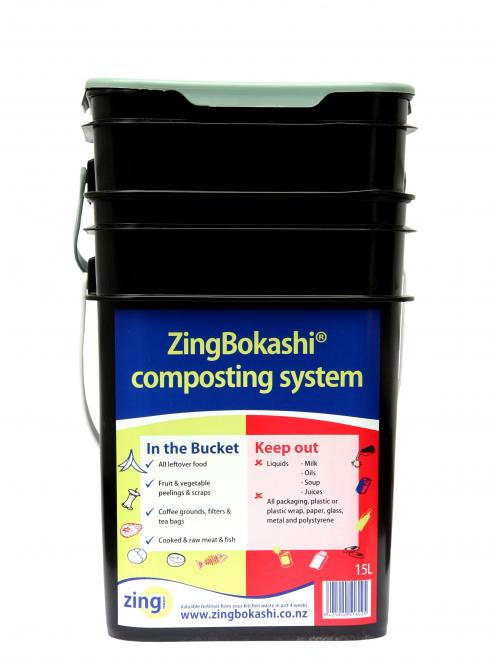 A Bokashi bin.
10. BOKASHI AND E.M. (EFFECTIVE MICROORGANISMS)
A Bokashi bin.
10. BOKASHI AND E.M. (EFFECTIVE MICROORGANISMS)

I'm such a monster fan of the Bokashi fermentation system - it's a stomping way of getting a humongous amount of nutrients into the soil along with a biological boost.
You can also buy E.M., which is a liquid form of the Bokashi bran. There are many recipes using E.M. At its simplest, you can mix some E.M. liquid and molasses, foliar spray your plants and drench the soil. This is a great way to encourage nutrient cycling in the soil (making nitrogen available), as well as general soil and plant health.
11. NO DIG GARDENING
This can mean two different things.
A. Building a no-dig garden directly on to the soil, with multiple layers of ingredients. Essentially you're building a small compost heap directly on to the vege bed.
B. Don't dig your soil up. Every time you turn the soil, you cause havoc. You destroy fungal relationships and the soil structure you've created gets mashed up. The use of a garden fork or broadfork a couple of times a year is a great way of creating some aeration in the soil without munting it.
12. WATERING
Yes, I keep harping on about organic matter, which is the key to not leaching nitrogen and other goodies out of our soils and holding moisture. Be wary of over-watering and conversely under-watering. It's worth turning your irrigation off during those big rain events.
The key to success is promoting the growth of organic matter levels in the soil and promoting soil biology. Multiple approaches keeps it interesting and challenging for us, we also get to observe what our soils are doing. Really as gardeners, we're growers of soil rather than plants.
Five ways to reuse your newspaper in the garden
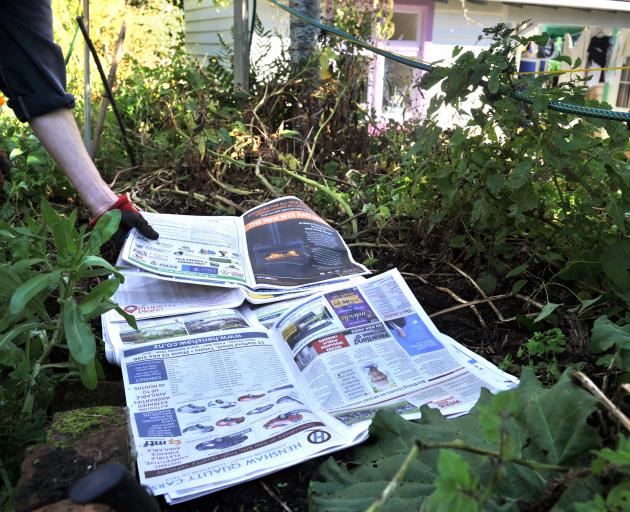



5.Pathways can lead us to tear our hair out in frustration. Thick layers of newspaper can be the answer. Put old carpet or planks of wood on top to hold it down and keep it looking tidy. You can keep adding more newspaper as time goes by. The worms will come up and take a nibble.
The Dr Compost project is funded by the Queenstown Lakes District Council and delivered by Wastebusters to reduce organic waste going to landfill. Food and garden waste can break down in the landfill to release methane, a harmful climate change gas.



